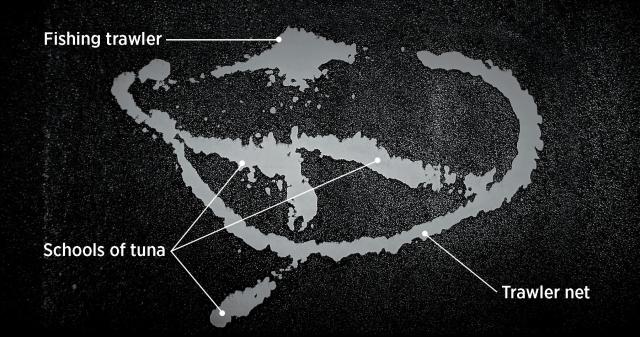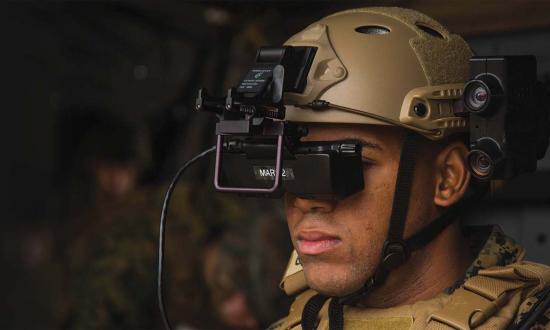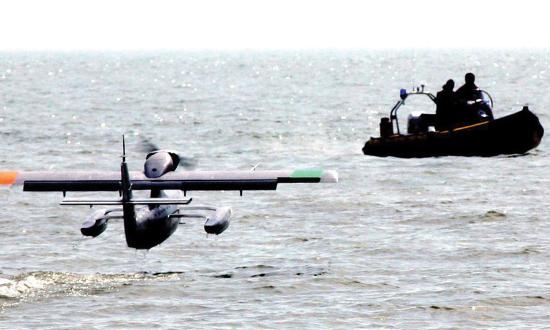In 1942, a German captain warned his fellow U-boat commanders: “The most dangerous feature of American waters is phosphorescence—at night—due to aircraft and destroyers. Beware that if you travel at periscope depth, vortices off your cannon and screws will show up as phosphorescence.”1 Innovative efforts today, combining low-light sensors, advanced signal processing, and swarming unmanned aerial vehicles (UAVs) could provide a comparatively inexpensive, nighttime antisubmarine warfare (ASW) capability through deliberate use of “phosphorescence,” more correctly called bioluminescence.
While night-vision devices have been used mainly for land warfare, the possible use of low-light sensors at sea is compelling, when the night is dark and the ocean luminous. Figure 1 is an image from a low-light camera flown on a Cessna aircraft off Baja, California, in 1974.2 A fishing trawler is winching in a school of tuna as some of the fish escape through a hole in the net, at a depth of around 90 feet. The light signatures are caused by the movement of the ship, net, and fish through water filled with bioluminescent plankton. The four-foot-long camera pod weighed 150 pounds, and the imagery was recorded on a black-and-white VHS tape, with no signal processing.
The Technologies
First, commercial off-the-shelf low-light sensors today are excellent. For example, astrophotography hobbyists can buy a low-light camera for about $1,200. Its sensor is two square inches, weighs less than two ounces, and counts individual photons per pixel.³ The whole camera system fits in the palm of a hand and weighs less than five pounds.
Second, image enhancement techniques for visual sensing are very similar to signal processing for acoustic and electromagnetic sensors. Co-registering video frames, stacking images, and subtracting background noise help improve the visual signal-to-noise ratio. Spectral, spatial, and temporal filters can result in orders-of-magnitude enhancement.
Third, the Office of Naval Research has been examining swarming drones and has awarded Raytheon a $30 million contractthrough its Low-Cost UAV Swarming Technology (LOCUST) program to develop a derivative of its Coyote loitering munition.4 The technology is still developmental but is maturing quickly.
An Ocean Signature
Bioluminescent phytoplankton glow when the water around them is disturbed; they feel the hydrodynamic forces of pressure increase and glow when anything large and potentially threatening passes by.5
Reexamine Figure 1 with the knowledge that the fishing trawler is 85 feet long, and north is located toward the top of the picture. With that additional information, the dimensions of each school of tuna and the heading of the escaping school can be determined. In less than 300 frames (five seconds) captured with 50-year-old technology, speed of movement and maneuvers can be seen. Imagine what could be accomplished today with better sensors and advanced signal processing.
The trawler, net, and schools of tuna are not glowing; the disturbed bioluminescent plankton are the source of light. This subtle but significant fact is important because light produced by disturbed bioluminescent plankton is an ocean signature; a submarine cannot prevent the ocean from glowing. Although common, it is not everywhere, and it doesn’t have to be; it just needs to be present where the fleet is operating to be relevant.
It is estimated that three-fourths of the deep ocean biomass can bioluminesce.6 This biomass, known as the “deep scattering layer,” migrates upward every night in a circadian rhythm, potentially exposing submarines at a variety of depths across much of the world’s oceans.7 A layer of bioluminescent jellyfish should be thought of as the light-equivalent to a shallow sound channel. Clearly, U.S. submarines should be aware of their light signatures when conducting shallow-water operations at night.
Double-Edged Sword
The Navy may already be late to using ocean bioluminescence. In September 2019, the South China Morning Post described China’s plan to network UAVs with low-orbiting satellites to provide surveillance capabilities over the South China Sea. The UAVs will fly beneath the clouds, employing visual sensors and onboard signal processing.8 The South China Sea is known to experience plankton blooms, referred to as “the blue tears of China.”9 Adding low-light sensors to the UAVs would not be much of a technical challenge.
ASW is often described as “awfully slow warfare,” and visually searching all night for uncued submarines—even in a limited, tactical search pattern—is not a mission aviators covet. But it is an ideal one for UAVs.
Low-light sensors should equip all airborne ASW platforms, manned and unmanned. Onboard signal processing and image enhancement software can employ artificial intelligence detection algorithms to do much of the preliminary assessment. The sensors should be used to complement and corroborate others, the same way magnetic anomaly detection is employed. Low-light sensors on UAVs can fly above helicopters and below P-8 Poseidons, filling the air-space-gap between—all monitored by one or two watchstanders.
A narrow field of view limits low-light sensing’s utility as a primary means for open-ocean search, even with a small-UAV swarm. But it could be valuable protecting surface ships in tactical search scenarios. Surface ship ASW and defensive tactics include evasive maneuvering, deceptive lighting, emissions control, and acoustic decoys, all designed to confuse the adversary’s tactical picture, which is more difficult to form at night. In response, submarines often operate at relatively shallow depths, maneuvering to keep up with and position to engage a target, making them vulnerable to bioluminescent layers. Fifty UAVs with a half-mile field of view could search along a 25-mile-wide line.
The greatest unknown is the presence, extent, and persistence of ocean bioluminescence. Oceanographers have been measuring the phenomenon for more than 40 years and have a very good climatology database—at certain depths. The Navy needs ongoing measuring capability similar to its expendable bathythermographs.
Visionaries Needed
The synergy of these emerging technologies has created the potential for a disruptive capability, which, by its nature, is often resisted by the status quo. What is needed is an aggressive system evaluation, and the Marine Corps may be just the naval service to perform one, consistent with Commandant General David H. Berger’s call to fight submarines.10 He also wants Marines to have more trust in robotic systems, particularly ones that significantly reduce the “sensor-to-shooter” process.11
Low-light sensors on swarming UAVs at night can reduce traditional ASW passive target-motion analysis from hours to seconds. The Marine Corps is hungry to make a difference, and it will not bring any ASW-community bias to a subject the Navy has been studying for decades.
The oceans do not care which side wins in maritime conflict, and the seas often favor submarines because they operate in only one physical realm. An argument can be made now that, with a low-light, swarming UAV capability, the odds at night shift to the side that leverages the phenomenon of bioluminescence to its advantage.
1. Michael Gannon, Operation Drumbeat (New York: Harper Perennial, 1990).
2. CAPT T. Q. Donaldson, USN, “Have You Seen the Light?” U.S. Naval Institute Proceedings 124, no. 6 (June 1998).
3. “SBIG STC-428-P Specifications,” Diffractionlimited.com (January 2021).
4. Kelsey Atherton, “Navy Office Awards $30 Million Contract for Drone Swarms,” C4ISRNET.com, 27 June 2018.
5. Liz Langley, “How Bioluminescence Works in Nature,” National Geographic.
6. Langley, “How Bioluminescence Works.”
7. Eric G. Barham, “Siphonophores and the Deep Scattering Layer,” Science 140, no. 3568 (17 May 1963): 826–28.
8. Liu Zhen, “Beijing Deploys Drones for South China Sea Surveillance,” South China Morning Post, 10 September 2019.
9. Jonathan Carey, “China’s Bioluminescent Blue Tears Are Beautiful and Associated with Toxic Blooms,” Atlasobscura.com, 14 June 2019.
10. Gen David H. Berger, USMC, “Marines Will Help Fight Submarines,” U.S. Naval Institute Proceedings 146, no. 11 (November 2020).
11. Megan Eckstein, “Berger: Marines Need to Trust Unmanned, AI Tools for Future Warfare,” USNI News, 2 February 2021.







